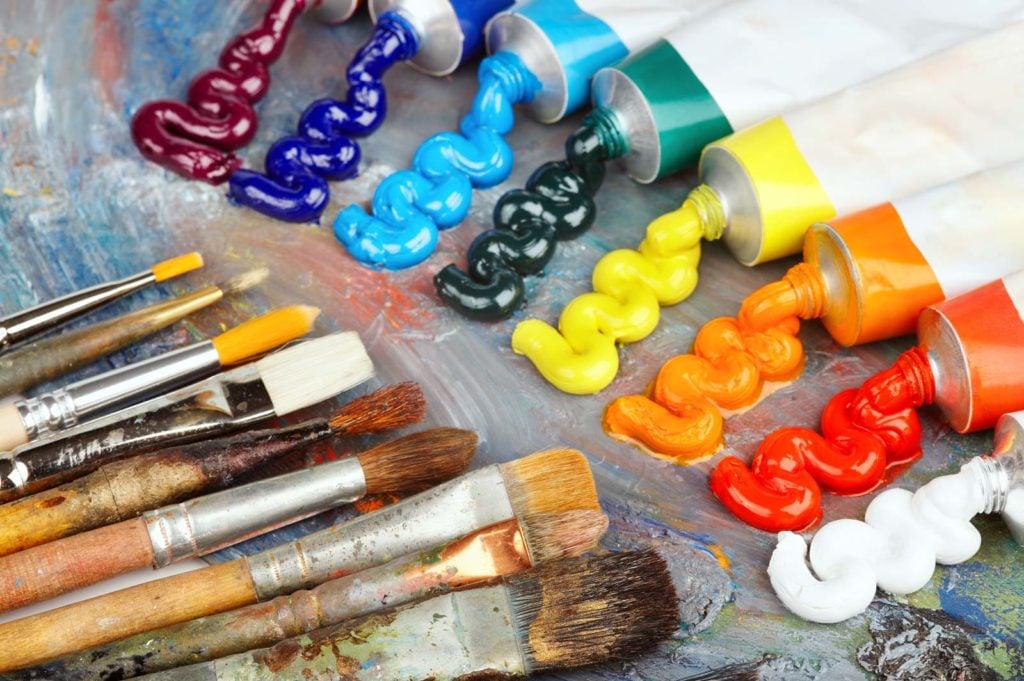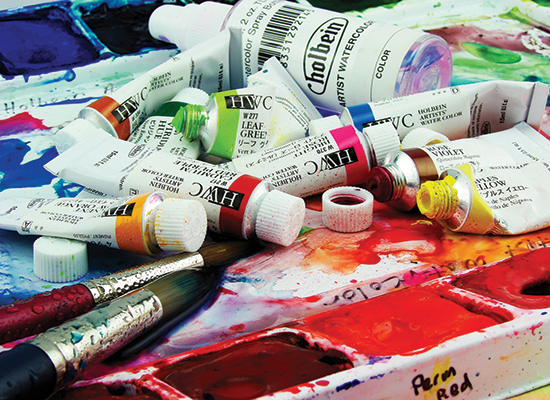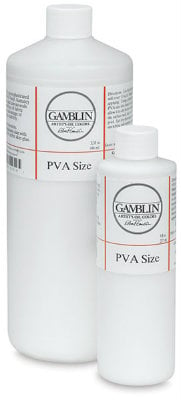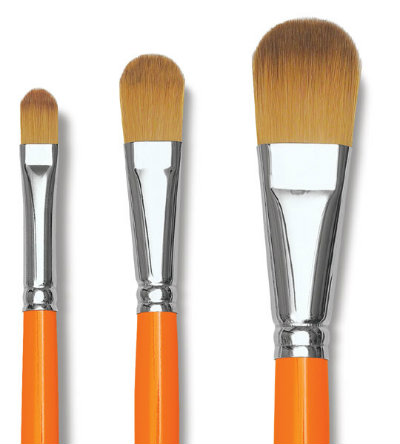Art World
Unsettled by the Dead Animals in Your Paint? Welcome to the World of Vegan Art Supplies
High-grade art supplies now offer conscientious artists professional-quality work materials free of animal products—or animal testing.

High-grade art supplies now offer conscientious artists professional-quality work materials free of animal products—or animal testing.

Dylan Kerr

The next time you see a watercolor painting—maybe one your child brought home from preschool, or a masterpiece by someone like Georgia O’Keeffe—try not to think about the all the bile that went into it. (Ox gall, the dried extract of bovine gall bladders, is a wetting agent widely used to give watercolors their famous liquid quality.)
If the painting happens to be on a canvas that’s been gessoed, add gelatin—the boiled skins, bones, tendons, and hooves of pigs and cows—to the list of things to forget about. And don’t ask how the canvas was sized, either (they probably used rabbit skin glue), or what kind of brush they chose to paint with (chances are good it was made from the fur of a ferret, squirrel, goat, or horse).
Artists don’t usually think of their work as a final resting place for animal parts. But from sepia (forcibly obtained from squid) and India ink (more crushed bugs) and to oil pastels (fat + beeswax) and charcoal (specifically Bone Black, which lives up to its name), critters’ bodies abound in all manner of art supplies. This isn’t unusual in the context of 21st-century consumerism; animals pop up in all kinds of products beyond meat and leather, especially if one includes those tested for safety on nonhuman “participants.”
It’s a state of affairs most people and companies prefer not to discuss, with one big exception: vegans, people who refuse to consume or utilize products that cause animal suffering in their manufacture.
As a result of increased awareness of farm animals’ plights, celebrity endorsements from figures ranging from Miley Cyrus to Morrissey, popular documentaries like Food, Inc., and a cultural shift towards both self-care and Instagrammable activism, vegans are becoming a consumer group to be reckoned with. And the market, as it always does, is shifting to accommodate them. Meatless burgers and cruelty-free shampoo have become commonplace. Now, thanks to dedicated activists and a few canny companies, vegan art supplies are on their way, too.
When it comes to art materials, a spate of new products is slowly appearing in shops, pushed by companies looking to distinguish themselves from the competition and cater to buyers looking to make art without contributing to the animal-industrial complex.
DaVinci and Holbein both produce gall-free watercolors that are available at most artist supply stores and e-commerce sites. These professional, artist-quality paints are considered among the top brands on the market, and they are comparable in price to their competitors based on current prices on the Dick Blick Art Materials website. Interestingly, these paints are barely advertised as being animal-free—Da Vinci makes no mention of the fact on their site, and Holbein references it only in passing—meaning that the paints largely stand on their own merits within the marketplace.

Holbein animal-product-free artist watercolors. Courtesy of Holbein.
In contrast, the German art-supply company Faber-Castell markets all their products—from colored pencils to jewelry-making tools—specifically as cruelty-free and environmentally friendly. (According to their website, the one exception is their beeswax crayons; they note that even their children’s craft kits “contain naturally fallen feathers and naturally abandoned sea shells.”)
The company’s India and sepia inks are made with inorganic and synthetic materials rather than shellac (a resin secreted by the female lac bug), gelatin, or squid ink, and their black pigments are produced from oil, coal, and wood in place of animal bones. Faber-Castell supplies are widely available internationally, and range in price and quality from top-of-the-line to cheaper “student-quality” offerings.

A selection of Faber-Castell crayons made without animal products. Image via Wikimedia Commons.
Susan Coe, an English artist and illustrator who grew up next to a slaughterhouse, focuses on animal rights in her searingly graphic drawings and prints and swears by several brands that are “vegan and of excellent quality.” She’s emphatic about Strathmore Bristol, which she calls the “number one paper, in every way, for pencil” and is made without the use of gelatin as most artist papers are.
Coe also uses Fabriano papers, most of which are sized with starch. She sticks to Derwent pencils, which do not contain beeswax or pure carbon sticks of graphite in a holder. Rather than using natural sponges for blending the graphite into the paper, Coe says that cosmetic sponges work even better, citing BeautyBlender as her chosen vegan brand. And, of course, she chooses synthetic over real fur brushes, with Raphaël Kaërell synthetic sable leading the pack.
Again, all of these brands are commonly available at larger art supply outlets, and can usually be ordered to a specific store if requested.

Derwent’s Inktense pencils are vegan-friendly. Courtesy of Derwent.
Jonathan Horowitz, a New York-based multimedia artist known for his explicitly political work, has also highlighted veganism and animal consumer culture in his work. His 2002 Greene Naftali exhibition “Go Vegan!” (which was restaged in 2010) featured images of celebrity vegetarians from Albert Einstein to Pamela Anderson coupled with ironic send-ups of America’s meat-loving culture.
Horowitz recommends PVA Size by Gamblin as an alternative to the ubiquitous rabbit skin glue used to prime and size canvases for painting, saying that it’s “actually more archival than rabbit skin glue [which is susceptible to yellowing over the years] and not terribly expensive.” In fact, based on Blick’s prices, Gamblin’s PVA is significantly cheaper than an equivalent amount of their own rabbit skin glue.

Gamblin PVA Sizing, a vegan alternative to rabbit skin glue. Courtesy of Dick Blick Art Materials.
For artists working outside of painting and drawing, vegan materials may hold even more possibilities than their more standard counterparts. Michael Assiff is a Queens-based artist whose conceptual and wide-ranging work touches on environmentalism, animal rights, and other contemporary social issues. His 2015 show “Hangry” (at the Lower East Side’s Shoot the Lobster) focused specifically on the connections between factory farming, state-level politics, and lifestyle apps like Tinder and Seamless.
Assiff categorizes his effort to replace animal products in his work as “generative,” relating a story about seeking out an alternative to animal hide for use in a recent piece. He landed on mushroom leather, a novel new material not yet widely available, by reaching out directly to its producers (an Italian company called Life Materials) and acquiring samples.

Raphaël Kaërell synthetic sable brushes. Courtesy Raphaël Kaërell.
“There are opportunities with these new alternative products to collaborate with the manufacturers,” he says. “Artists are a reliable lot to invent uses and techniques with new materials, and they can have a symbiotic relationship to new companies by adding to their portfolio.” Creating within constraints has long served as a reliable technique for sparking new ideas. At a time in art history where it seems that it’s all been done before, perhaps the radical recalibration that veganism requires can serve as a new tool for artistic innovation.
Coe echoes Assiff’s optimism on the possibilities of vegan supplies. She admits she “never thought going vegan was very hard—it’s cheap, and fun, and creative. There are vegan alternatives to nearly everything, and if there aren’t, we can invent them.”